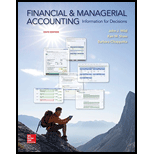
Concept explainers
Inventory:
Inventory refers to the stock or goods which will be sold in the near future and thus is an asset for the company. It comprises of the raw materials which are yet to be processed, the stock which is still going through the process of production and it also includes completed products that are ready for sale. Thus inventory is the biggest and the important source of income and profit for the business.
Periodic Inventory System:
In periodic inventory system, the changes in the stock items are reported periodically unlike recording as and when purchases or sales take place.
Last in First out:
In case of Last in, First out, also known as LIFO method, the inventory which was bought in the last will be taken out first.
Costs assigned to the ending inventory under periodic inventory system by applying LIFO method.
Want to see the full answer?
Check out a sample textbook solution
Chapter 5 Solutions
Financial and Managerial Accounting: Information for Decisions
- Stark Corp is in the process of acquiring another business. In light of the acquisition, shareholders are currently re-evaluating the appropriateness of the firm's capital structure (the types of and relative levels of debt and equity). The two proposals being contemplated are detailed below: Proposal 1 Proposal 2 Estimated earnings before interest and taxes (EBIT) $ 450,000 $ 450,000 Long term debt 1,000,000 2,000,000 Market value of equity 1,000,000 500,000 Interest rate on long term debt 10% 10% Tax rate 25% 25% Required Calculate the estimated return on equity (ROE) under the two proposals. (ROE = net income after taxes / market value of equity; net income after taxes = (EBIT - interest on long-term debt) × (1 - tax rate)).arrow_forwardI need guidance with this financial accounting problem using the right financial principles.arrow_forwardAtlas corporations price earnings ratio??arrow_forward
- Please provide the accurate answer to this general accounting problem using appropriate methods.arrow_forwardThe equity method of accounting is suitable for investments representing what? (1) Less than 20% ownership (2) Between 20% and 50% ownership (3) More than 50% ownership (4) Only for foreign investments answerarrow_forwardHelp this answerarrow_forward
- Gentry Co. reported total gross sales of $320,000, with 60% of these being credit sales. Sales returns and allowances of $18,000 apply only to the credit sales. A 1.5% sales discount was taken on all net credit sales. Additionally, credit card sales amounted to $110,000 and were subject to a 2.5% credit card fee. What is the dollar amount of net sales?arrow_forwardAlicia Industries has a net income of $89,000 and total assets of 445,000. What is the return on assets? A) 18% B) 20% C) 21.2% D) 15%arrow_forwardMontu Consultants Corporation obtained a building, its surrounding land, and a computer system in a lump-sum purchase for $375,000. An appraisal set the value of the land at $184,500, the building at $144,000, and the computer system at $121,500. At what amount should Montu Consultants record each new asset on its books?arrow_forward
- accounting questionsarrow_forwardHow much are the total assets of the firm?arrow_forwardEddie Woodworks manufactures custom shelving. During the most productive month of the year, 4,200 units were manufactured at a total cost of $73,500. In the month of lowest production, the company made 1,600 units at a cost of $49,800. Using the high-low method of cost estimation, total fixed costs are__. a. $22,200 b. $30,600 c. $35,208 d. $45,000arrow_forward

 AccountingAccountingISBN:9781337272094Author:WARREN, Carl S., Reeve, James M., Duchac, Jonathan E.Publisher:Cengage Learning,
AccountingAccountingISBN:9781337272094Author:WARREN, Carl S., Reeve, James M., Duchac, Jonathan E.Publisher:Cengage Learning, Accounting Information SystemsAccountingISBN:9781337619202Author:Hall, James A.Publisher:Cengage Learning,
Accounting Information SystemsAccountingISBN:9781337619202Author:Hall, James A.Publisher:Cengage Learning, Horngren's Cost Accounting: A Managerial Emphasis...AccountingISBN:9780134475585Author:Srikant M. Datar, Madhav V. RajanPublisher:PEARSON
Horngren's Cost Accounting: A Managerial Emphasis...AccountingISBN:9780134475585Author:Srikant M. Datar, Madhav V. RajanPublisher:PEARSON Intermediate AccountingAccountingISBN:9781259722660Author:J. David Spiceland, Mark W. Nelson, Wayne M ThomasPublisher:McGraw-Hill Education
Intermediate AccountingAccountingISBN:9781259722660Author:J. David Spiceland, Mark W. Nelson, Wayne M ThomasPublisher:McGraw-Hill Education Financial and Managerial AccountingAccountingISBN:9781259726705Author:John J Wild, Ken W. Shaw, Barbara Chiappetta Fundamental Accounting PrinciplesPublisher:McGraw-Hill Education
Financial and Managerial AccountingAccountingISBN:9781259726705Author:John J Wild, Ken W. Shaw, Barbara Chiappetta Fundamental Accounting PrinciplesPublisher:McGraw-Hill Education





